What to Expect from WordPress 6.1
Late fall brings exciting news to the WordPress community as WordPress 6.1 is scheduled for release on Tuesday, November 1, 2022. It is the third major WordPress release this year, which will follow WordPress 6.0 Arturo, released on May 24, and WordPress 5.9 Josephine, released on January 25. WordPress 6.

Late fall brings exciting news to the WordPress community as WordPress 6.1 is scheduled for release on Tuesday, November 1, 2022. It is the third major WordPress release this year, which will follow WordPress 6.0 Arturo, released on May 24, and WordPress 5.9 Josephine, released on January 25.
WordPress 6.1 has already drawn the attention of thousands of website owners who could not wait to be among the first to discover the spectacular new functionality. On October 25, WordPress 6.1 Release Candidate 3 (RC 3) became available for the WordPress community to perform final reviews.
The iThemes team has been keeping track of numerous updates during the development process. We are ready to share our excitement with you as we unpack the most notable features of WordPress 6.1 in this comprehensive guide to the upcoming WordPress release.
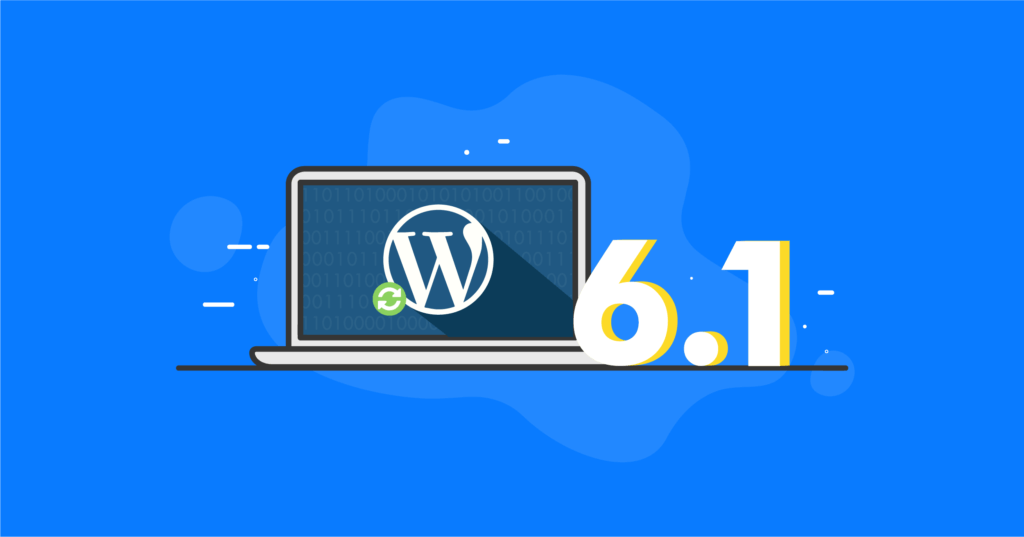
WordPress 6.1 in a Nutshell
WordPress has put in enormous effort in bringing together hundreds of improvements to the WordPress core and the Gutenberg editor. Eleven versions of the block editor will be merged into the WordPress core, providing the WordPress community with a totally refined content editing experience.
WordPress 6.1 presents major performance, development, and accessibility enhancements. WordPress users will see various improvements to the existing blocks and the new Table of Contents block.
- Full Site Editing. WordPress 6.1 introduces more templates and extends patterns to all post types.
- New blocks. WordPress 6.1 includes the new Table of Contents block. WordPress users will now be able to add a table of contents to the post without using any third-party solutions.
- Various improvements to the existing block types. WordPress 6.1 will leverage various improvements to Columns, Comments, Categories, Cover, Gallery, Quote, Image, List, and Navigation blocks.
- New default block theme with multiple enhancements. WordPress 6.1 introduces Twenty Twenty-Three with 10 style variations and new custom templates.
- Major performance improvements. Various optimizations are included into 19 components of WordPress. The most notable improvements are caching queries for WP_Query, fewer queries on REST API calls, and new Site Health checks.
- Accessibility improvements. WordPress 6.1 brings together a number of accessibility improvements to the WordPress admin dashboard, login and registration forms, and Site Editor.
- Enhanced development experience. WordPress 6.1 includes a number of new functions and hooks that simplify data access and bring other improvements to the development process.
- No JPEG to WebP conversion. Despite the initial plans to have automatic JPEG to WebP image conversation included, it has been pulled out from WordPress 6.1. This exclusion is due to users reporting an increased resource usage on image upload.
Before You Update: Don’t Forget to Run a Backup Of Your Site!
As WordPress 6.1 becomes available to the broad community, you will be able to update WordPress core to the newest version through your admin dashboard. As exciting as it may seem, do not forget to run a full backup of your website before installing WordPress 6.1.
The new backup must contact both the WordPress database and all website files stored on the disk, including plugins, themes, and the media library. In case any code incompatibilities surface after the WordPress core update, you will be able to easily revert all changes to restore your website functionality.
BackupBuddy, the industry-leading data protection and recovery solution for WordPress will help you build a strong backup strategy to handle all updates with confidence. Leverage the enhanced content creation experience being sure a copy of your website is safely stored at a remote location.
10 Key Improvements to Gutenberg Blocks in WordPress 6.1
Blocks have become the centerpiece of content development since the introduction of the Gutenberg editor and undergo major changes with each new WordPress release. We will start reviewing the new block design tools by breaking down the ten key improvements to the Gutenberg blocks:
- Border customization for the Columns block.
- Various improvements to the Comments block.
- Changes to the Categories block behavior.
- New Table of Contents block.
- Horizontal and vertical spacing in the Gallery block.
- More design tools for Post Navigation Links.
- Featured images in the Cover block.
- Border controls for the Image block.
- Enhanced List block.
- Navigation block improvements.
Border Customization for the Columns Block
Border customization for the Columns block has become one of the most important improvements that Gutenberg 13.1 presented to the world back in April 2022.
The block supports and the global styles border panel has been updated and now uses the newly added BorderBoxControl component. It allows WordPress 6.1 users to specify custom borders for columns, creating new unique styles. WordPress developers can now set individual borders in the theme.json file.
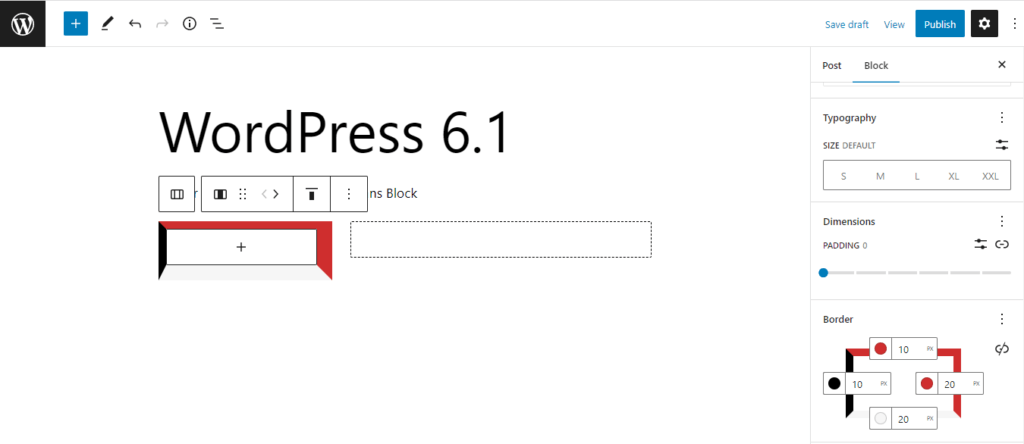
Various Improvements to the Comments Block
The list of new features Gutenberg 13.1 has provided to WordPress 6.1 does not end with an updated Columns block, and various improvements have been introduced to the Comment block. WordPress website owners are now able to leverage more advanced editing features, most notably, the Comments Title block with much richer compositions.
WordPress went even further and introduced numerous bug fixes to the Comments block fix styles and correct messaging in Gutenberg 13.2 released later this year.
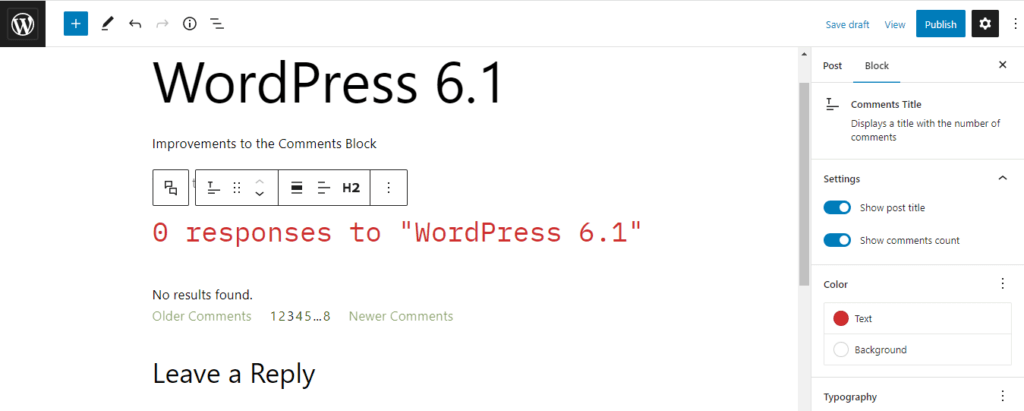
Changes to the Categories Block Behavior
Starting from the 6.1 version, WordPress users will see a difference in the Categories block’s behavior with empty categories. Instead of having them hidden as the option chosen by default, you can now choose to show them on the page.
Before this functionality was added to Gutenberg 13.1, website owners had to resort to using shortcodes to get this functionality.
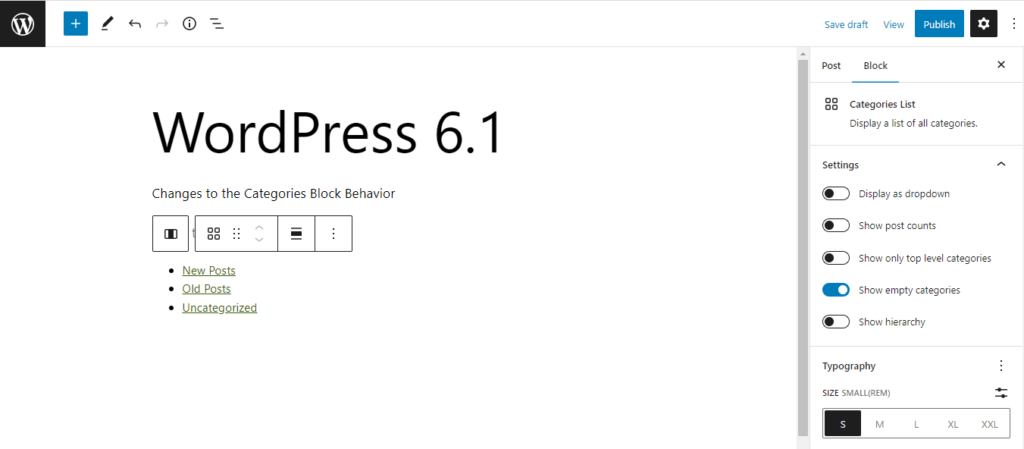
New Table of Contents Block
Gutenberg 13.3 introduces the Table of Contents block as a way to summarize your content with a list of headings for enhanced page navigation and user experience. Having a table of contents is one of the essential features for search engine optimization, which will now be available by default in WordPress 6.1 and later versions.
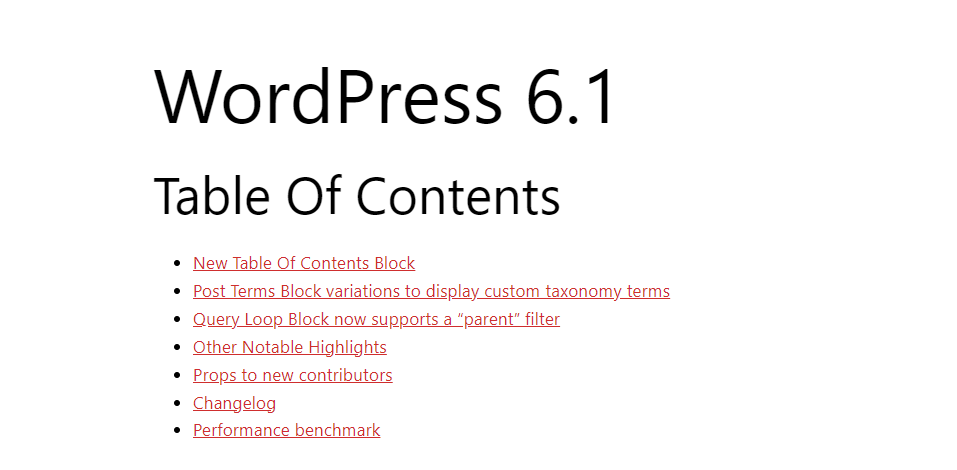
Horizontal and Vertical Spacing in the Gallery Block
Gutenberg 13.4, released back in summer, features the new axial spacing in the Gallery block’s dimensional panel. It allows you to specify different horizontal and vertical gaps for images in the Gallery block when creating image galleries.
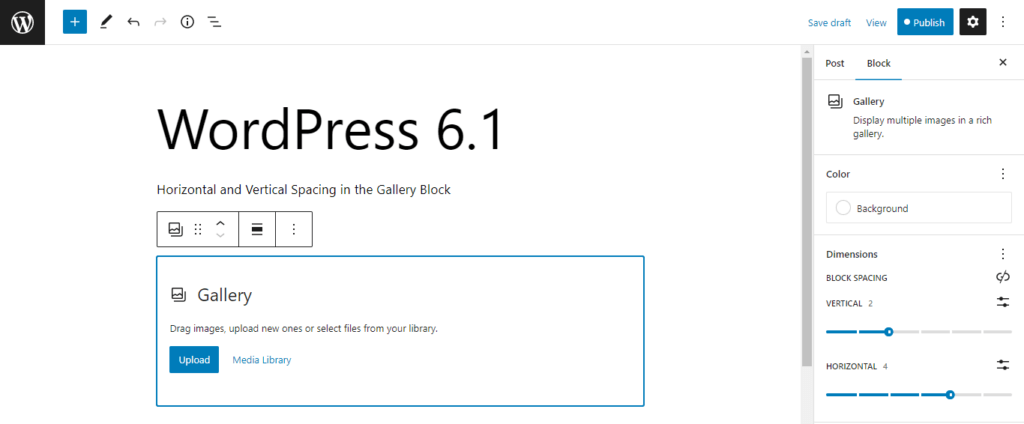
More Design Tools for Post Navigation Links
Gutenberg 13.5 allows WordPress website owners who use themes with support for the appearanceTools setting property to customize the color and font family for the Post Navigation Link. As the functionality becomes available in WordPress 6.1, you will no longer have to tweak CSS manually for this purpose.
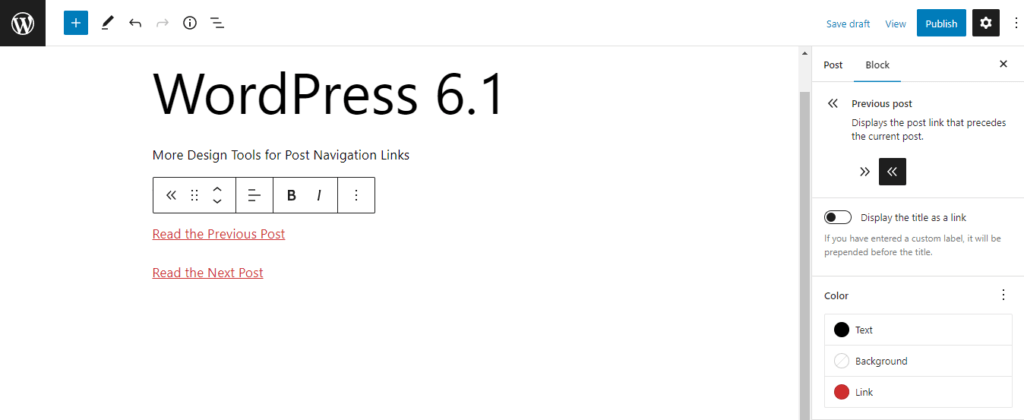
Featured Images in the Cover Block
With the release of Gutenberg 13.5, featured images can be added from the Cover block placeholder directly, making it easier to take advantage of this critical content element. Having the option to use a featured image available in the media replaced flow ensures an improved user experience interacting with media in the block editor.
Gutenberg 13.7 allows WordPress users to select the Use a featured image option directly from the placeholder for a new Cover block.
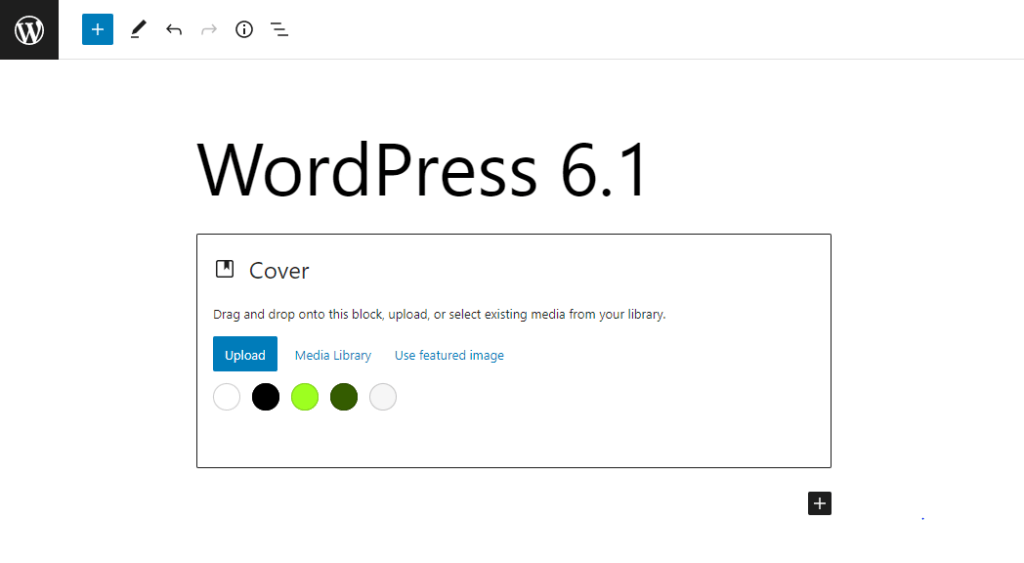
Border Controls for the Image Block
Gutenberg 13.8 introduced support for a wide range of border controls for the Image block, including Color, Style, and Width. Having the ability to add borders with custom color selection allows for more compelling layouts and patterns in WordPress 6.1.
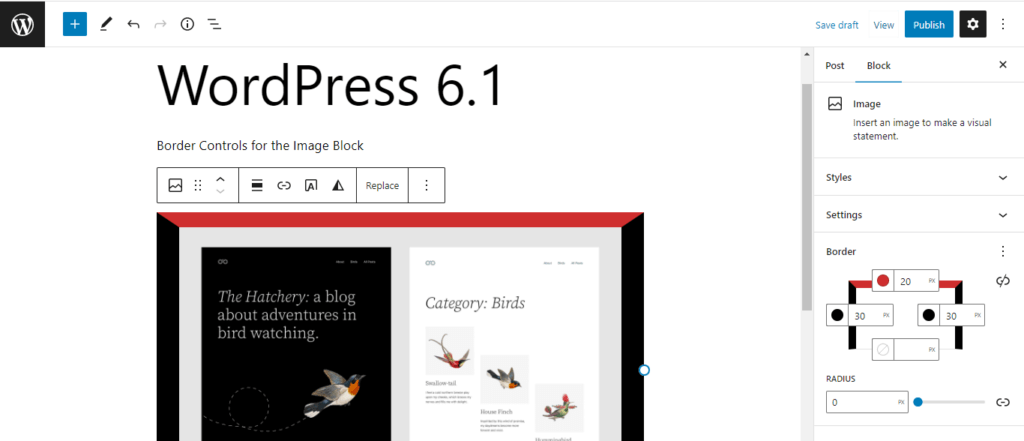
Enhanced List Block
The List block has always been particularly useful in organizing content in either numbered or bulleted lists. The release of Gutenberg 14.0 makes it possible to easily sort your list items by using inner blocks.
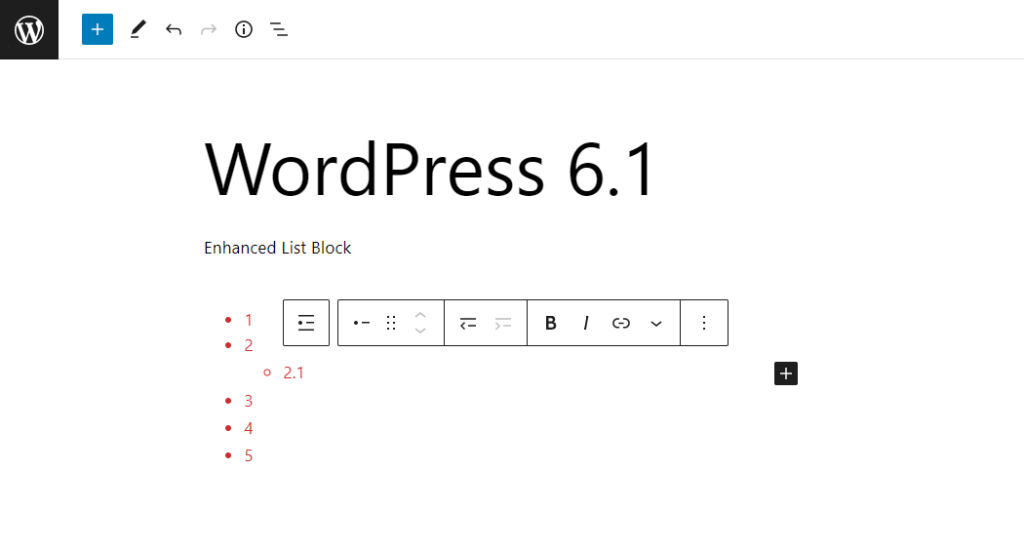
Navigation Block Improvements
Gutenberg 14.1 has introduced various improvements to the Navigation block. More specifically, the menu selector has been moved from the Navigation block toolbar to the new section in the inspector sidebar. You can now access the menus you have created by using the Manage menus button.
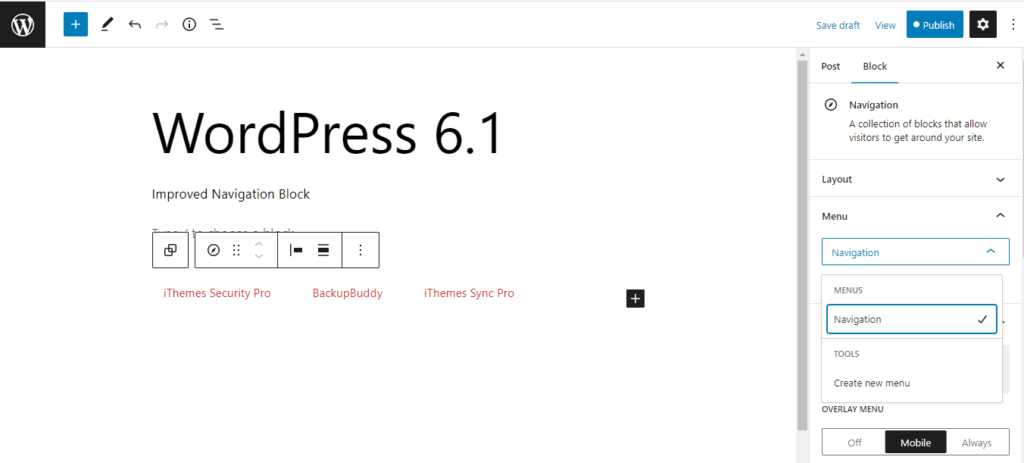
Top 5 Block Editor Improvements in WordPress 6.1
Ten Gutenberg releases are being brought together to provide an elevated content development experience. Moreover, major efforts have been put in to make Gutenberg features more accessible in classic themes to significantly simplify the transition to block-based themes.
In this section of the guide, we are listing the top five block editor improvements to look out for in WordPress 6.1. We will discuss how the following features will dramatically improve Gutenberg editor’s functionality for all website owners:
- Improved content locking experience.
- Support for fluid typography.
- Padding and margin visualization.
- Improvements to the placeholders.
- The new Time to read feature.
Improved Content Locking
WordPress 6.1 introduces content-only editing for blocks, templates, and patterns. Content-locked blocks now have block alignment and resizing, as well as duotone filters disabled.
New releases of Gutenberg have a new experimental type of locking known as contentOnly. When contentOnly is enabled, website owners can only change the nested content within the block or pattern. The structure of the chosen block starts behaving as a single unit with its hierarchy fully hidden, so the user is only able to change text and media URLs.
The block types that do not have any content are hidden from the List View, and the sidebar only shows the list of content blocks a user can modify. This makes it much less likely for a website administrator to break the expected layout.
Support for Fluid Typography
Gutenberg 13.8 has introduced support for fluid typography, a new feature for creating responsive designs. Fluid typography defines the way the font sizes on your WordPress website adapt to changes in screen size based on the minimum and maximum values assigned to the style.
The upcoming release of WordPress 6.1 will have the block editor add a way for themes to opt into fluid typography out-of-the-box via the calc/clamp CSS functions.
Padding and Margin Visualization
Gutenberg 13.2 has enabled support for padding and merging visualization, which helps see the changes to one of the two options more clearly as you are editing a certain content block. It is achieved by displaying a blue box, which, however, quickly fades out.
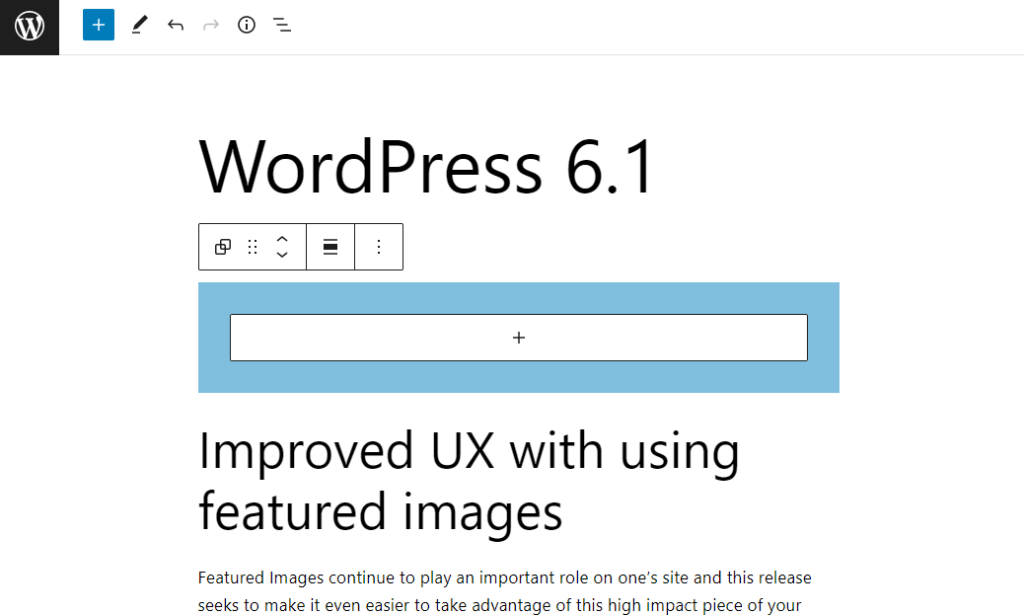
Improvements to the Placeholders
Along with padding and margin visualization, Gutenberg 13.2 offers notable improvements to the placeholders. Several blocks, including the Post Content, Post Excerpt, and Comments, will now show more realistic placeholders, which will help you get a better understanding of what your website will look like with real content.
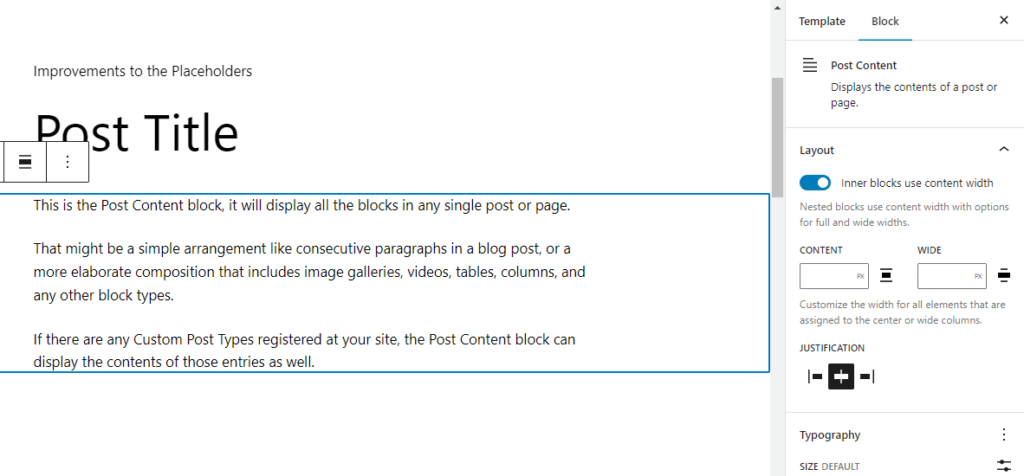
The New Time to Read Feature
The newest Gutenberg release, the 14.1 version released in September, introduced the new Time to Read feature. In WordPress 6.1, accessing the information panel through the top bar will show you a new number.
In addition to the number of words, characters, headings, paragraphs, and blocks, you will also see the estimated time of reading the chosen document. This can be a page, post, or a custom post type.
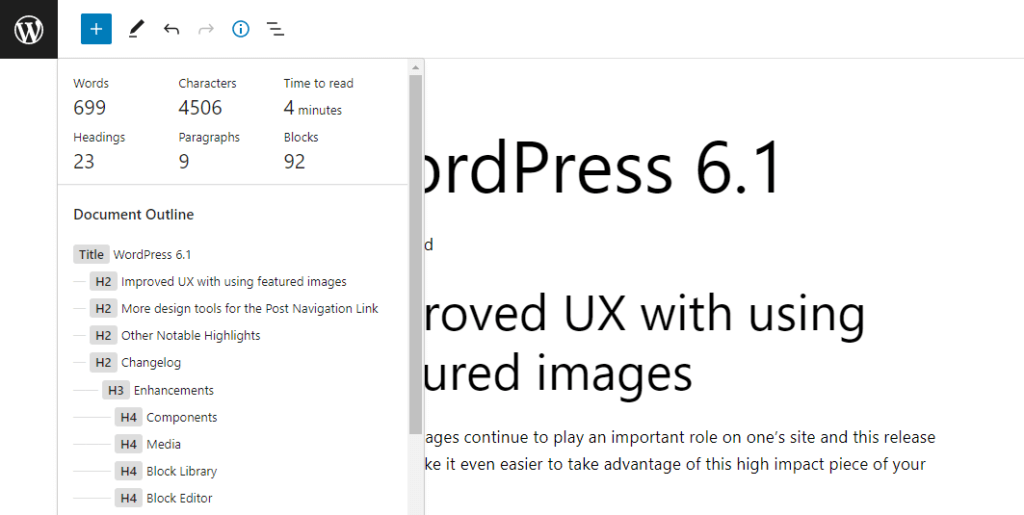
New Post Time to Read Block
What is also quite notable is that around three months ago, back on July 20, 2022, a request for the new Post Time to Read block was put in to have the estimated time of reading displayed on the front end of the website as well. The Post Time to Read block is currently being developed, and it’s not unlikely that WordPress users will be able to leverage the new block in the upcoming WordPress 6.2 release.
Full Site Editing Improvements in WordPress 6.1
WordPress has been on the path to Full Site Editing since the release of Gutenberg as part of WordPress 5.0 before finally introducing it in WordPress 5.9. Following the WordPress 6.0 FSE improvements, WordPress 6.1 will provide an even better editing experience to all WordPress website owners.
One of the major enhancements to look for in the upcoming release are new template types and improved patterns. Here is a quick recap of Full Site Editing before we can dive into the new improved FSE functionality WordPress 6.1 offers.
Full Site Editing: 3 Main Things to Keep in Mind
As usual, iThemes provides a quick overview of Full Site Editing to keep you updated on the latest developments.
- You need a block-based theme to actually use Full Site Editing. A block theme provides templates entirely composed of blocks. It means that, in addition to the post content of the different post types, the block editor can also be used to customize all areas of your WordPress website, including headers, footers, sidebars, and more.
- You can now use WordPress default block themes. Twenty Twenty-Two, released with WordPress 5.9, became the first default block theme in WordPress history. Twenty Twenty-Three, a new theme introduced by WordPress 6.1.
- WordPress native FSE capabilities may not be so advanced yet. Many WordPress website owners still give preference to themes like Kadence WP that can largely outshine the WordPress native FSE capabilities. Kadence Blocks, used by over 300,000 WordPress sites, offers a library of powerful WordPress blocks that will help you build spectacular dynamic web pages without any limitations.
More Template Types and Improved Patterns
Following a large number of user requests, WordPress has been working on expanding the list of templates available from the Site Editor. With the introduction of Gutenberg 13.6, website owners can now create a template for all posts or a specific post type.
For example, if you launch the Site Editor with Twenty Twenty-Three theme activated, eleven templates and four template parts will be shown. The following custom templates are available in addition to the default ones:
- Blank
- Blog (Alternative)
- 404
- With Featured Image
- With Cover Block
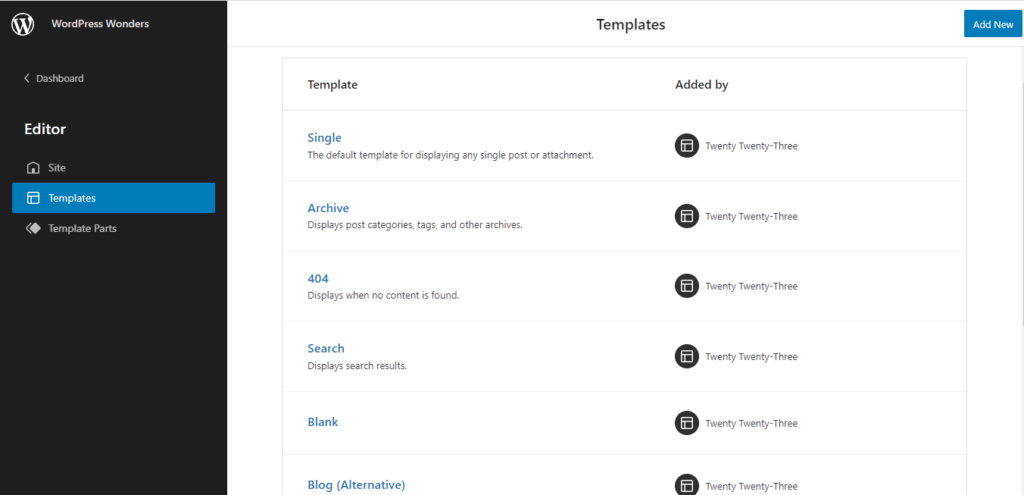
This has become an amazing addition to having a list of patterns to choose from appear every time a user creates a new page – the feature that the world was able to see in WordPress 6.0. The WordPress 6.1 release, however, goes even further and extends this feature to all post types. To enable support for this feature, you need to include core/post-content in your pattern’s blockTypes and set the relevant postTypes.
Twenty Twenty-Three as the New Default WordPress Block Theme
Following the release of Twenty Twenty-Two, the first default block theme, in WordPress 5.9, WordPress 6.1 introduces major native theme improvements as the new Twenty Twenty-Three theme is brought to the public. Twenty Twenty-Three is the brand new default WordPress block theme with 10 style variations and other enhancements.
What is especially amazing about Twenty Twenty-Three is that the WordPress community has been on the front line of designing the theme, with over 30 different style variations received from 19 active contributors. The WordPress team has then chosen 10 style variations to be shipped with the Twenty Twenty-Three theme.
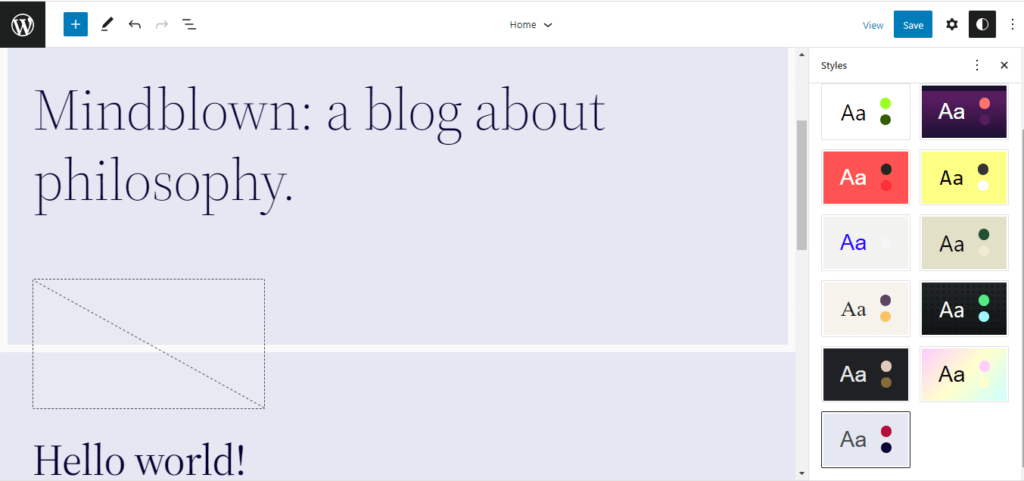
Twenty Twenty-Three is extremely lightweight and flexible. As a minimalist theme with no images and limited functionality, the new default block theme is perfect for exploring the new features of WordPress 6.1, including new template types and improved patterns.
5 Major Performance Improvements in WordPress 6.1
WordPress keeps including various performance updates to make the best of the database-driven architecture and its APIs with the use of caching. In WordPress 6.1, website owners are expected to notice a major performance boost as various improvements are released for WP_Query, REST API, and more.
Below, we are diving into the 5 major performance optimizations in WordPress 6.1. The whole list of improvements to all 19 components of WordPress are outlined in the Performance Field Guide for WordPress 6.1.
Query Caching in WP_Query
WordPress 6.1 adds the much anticipated query caching for the WP_Query class. This results in far fewer queries to the database, ensuring faster response times and improving the overall performance of your WordPress website.
WordPress users that already have persistent object caching enabled, will still benefit from the new feature, a database query will not run again until caches are invalidated. All calls to the WP_Query class will now be cached going forward.
Fewer Database Queries on REST API Requests
WordPress 6.1 brings a number of major improvements for REST API for elevated website performance. The set of updates ensures less database queries are performed on each REST API call.
In WordPress 6.1, the prepare_links method is only called if requested in the response. Before the new WordPress release, the method was called in all controllers, even if the links field was not requested and would never be returned.
New Site Health Checks
WordPress 6.1 includes two new Site Health checks – Persistent Object Cache and Page Cache, and a number of new filters.
The two checks determine whether your website is using these types of caching, and if not, give recommendations to enable both. The new filters help provide more specific steps after evaluating your infrastructure setup.
Cache API
Various improvements to Cache API bring validating cache keys in WP_Object_Cache methods and deleting cache by group. On top of that, a number of private cache priming functions are now made public, making them available to use in plugins and themes.
Database Improvements
WordPress 6.1 users will see a small performance improvement, as identifiers such as Field Names are now escaped with the %i placeholder. This will also help prevent SQL injection attacks.
3 Main Accessibility Improvement Areas
The new release brings together various WordPress 6.1 accessibility improvements spread over 13 components. Substantial changes have been made to the WordPress admin interface, login and registration forms, and Site Editor.
WordPress Admin
A number of pages in the WordPress admin interface have been modified to provide a better user experience. Some of the changes include improvements in color contrast and input fields, as well as an increased accessibility for some success/error messages within the admin panel.
Login and Registration
WordPress 6.1 introduces significant improvements to the login and registration forms, addressing many long-standing issues. WordPress users will now see proper labels for required fields and radio buttons.
WordPress will now explicitly associate error messages with input fields, making it easier for website owners to understand what steps they need to take to address those issues.
Site Editor
WordPress has been improving the Site and Template editors, addressing some known accessibility issues. For example, the template action buttons had a new label added, which fixed lack of context for improved accessibility.
Enhanced Development Experience
WordPress 6.1 comes with a number of new hooks and functions to provide an enhanced development experience. We are listing some of the main improvements below.
- New React hooks for simplified data access. The new hooks are provided by the @wordpress/core-data JavaScript package.
- Moving block CSS to JSON. WordPress 6.1 makes it possible to express styles in block.json, however, this feature is marked as experimental.
- New filters for theme.json data. WordPress 6.1 includes more filters to include into the theme.json data.
- The new is_login() function. The new function added with the new WordPress release will provide an easy way to determine if the current screen viewed is the login screen.
- Searching REST resources by ID across subtypes. With an enhancement to the search controller, it is now possible to retrieve a term or post object over the REST API using the resource’s ID and object type.
How to Update to WordPress 6.1
On November 01, when WordPress 6.1 is officially released, you will see an option to update WordPress from the admin dashboard. The Updates page will show the new release available. Do not forget to back up your WordPress website before running a core update to enjoy new features without having to worry about any functionality loss.
If you are running more than one WordPress website, iThemes Sync Pro will help you manage multiple WordPress websites from a single dashboard. Leverage one-click updates, advanced uptime monitoring, and SEO metrics tracking with your personal WordPress website assistant.
Wrapping Up
As the third and last major WordPress release of the year, WordPress 6.1 will be introduced to the broad WordPress community on the first of November. Eleven versions of the Gutenberg editor will be merged into the WordPress core.
A new block, Table of Contents, and several improvements to the existing blocks will make their way to your WordPress website. You will also see Twenty Twenty-Three, the new default WordPress block there with 10 style variations.
The WordPress platform is becoming even faster and more secure, re-establishing its place as the most popular content management system in the world.
iThemes continues offering the industry-leading solutions for WordPress security and data recovery to extend the native capabilities of the platform. Unlock the power of iThemes Security Pro and BackupBuddy to supercharge your WordPress website with the new WordPress 6.1 release.

Update All Your WordPress Sites From One Dashboard
Instead of logging into multiple WordPress sites to perform updates, you can update them all from one central location. iThemes Sync is designed to make managing multiple WordPress sites quick and easy.
Sign up now — Get SolidWP updates and valuable content straight to your inbox
Sign up
Get started with confidence — risk free, guaranteed
